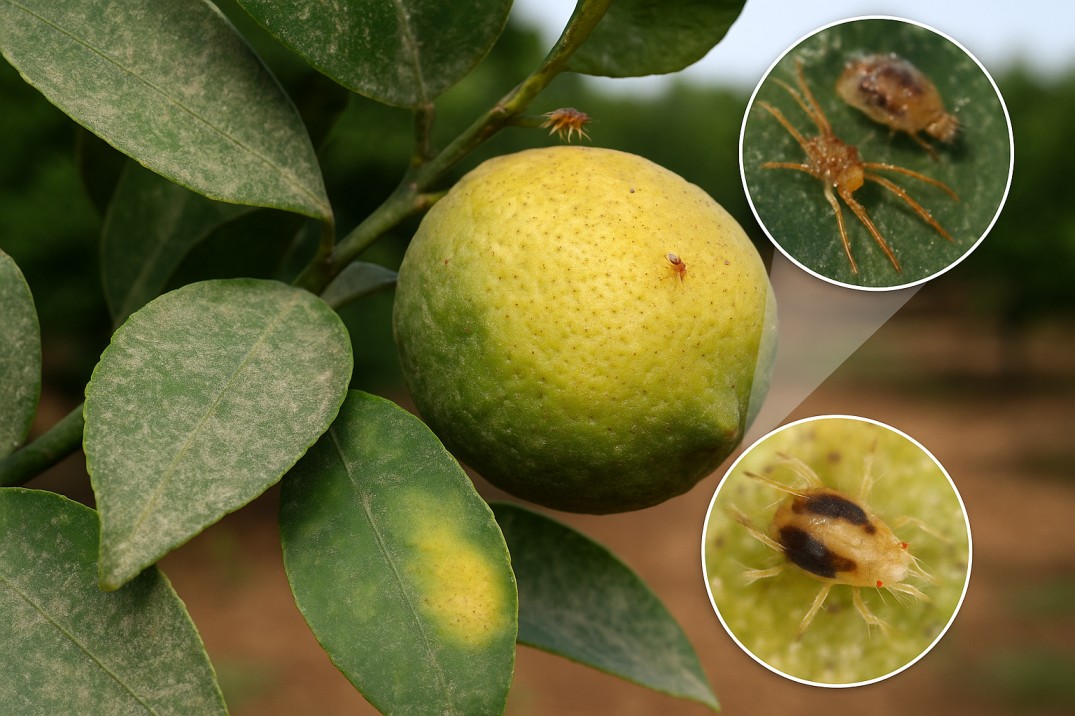Eutetranychus vs Tetranychus: How to Differentiate Between the Most Problematic Mites in our Citrus Farming
Sep, 2025 • Written by: Josep Sesé Fornés

In Valencian citrus farming, tetranychid mites represent a growing phytosanitary challenge. Although the presence of Tetranychus urticae (common red spider mite) is widely known, other species from the same group have gained relevance in recent years, such as Eutetranychus orientalis (oriental mite) and Eutetranychus banksi (Texas mite). Despite their apparent similarity, these species differ in morphology, damage, and biological behavior, which means that their management must also be different. Confusing them can lead to wrong control decisions and avoidable agronomic losses.
In addition, mites of the genus Eutetranychus are progressively displacing Panonychus citri (citrus red mite) in various citrus-growing areas of Valencia, demonstrating a strong adaptation and a progressive transformation of the pest mite community.
This post offers a clear and concise comparison to help technicians and farmers recognize the key differences between these mites and adjust their monitoring and treatment strategies.
Differences that stand out
Although they appear similar to the naked eye, these mites show very different morphological features when viewed with a magnifying glass:
| Feature |
Tetranychus urticae |
Eutetranychus orientalis / E. banksi |
| Coloration | Greenish yellow to reddish, with two lateral dark spots | Reddish to brown, with lateral dark spots |
| Body shape | Oval in females, narrower in males | Female oval, male with pointed abdomen |
| Front legs | Normal | Elongated and directed forward |
| Presence of silk | Abundant (visible nests) | Scarce or none |
Key Fact: An error in this initial identification can result in an ineffective control plan.
Symptoms in the field don't lie
The way each species feeds and colonizes leaves leaves very different traces:
| Feature | Tetranychus urticae | Eutetranychus orientalis / E. banksi |
| Part of the affected leaf |
Underside (where they form colonies) |
Bundle (although they can go the other way around on shoots) |
| Leaf damage | Well-demarcated yellow chlorotic patches | Diffuse discoloration or yellowing in general |
|
Fruit damage |
Dark spots, rubbing areas ("moustache") | Diffuse marks, roughness, loss of brightness |
| Other effects | Spider web, leaf drop | Less webbing, may drop if stress is present |
Knowing your cycle is winning the battle
The biological cycle and developmental conditions of each species also help to differentiate them. The time to act also varies by species:
| Characteristic | Tetranychus urticae | Eutetranychus orientalis / E. banksi |
| Population peaks | Maximum in August | Peak in late summer - early autumn |
| Preferred humidity | Low to moderate | Low (especially in the case of E. banksi) |
| Distribution | Common throughout the Mediterranean basin | Recent expansion from Andalusia to the Levant |
| Hosts | Most relevant in clementines | Lemon trees, grapefruit, early Navel type oranges |
Expert advice: Monitoring with visual support and digital diagnostics (AI apps) reduces errors and optimizes treatments.
.jpg?width=1200&length=1200&name=Hembra%20Adulta%20de%20T.%20Urticae%20%20(1).jpg)

.png?width=1200&length=1200&name=Macho%20y%20hembra%20de%20E.%20banksi%20(1).png)
.jpg?width=1200&length=1200&name=HojaT.%20Urticae%20%20(1).jpg)
Conclusion
● In today's citrus farming, it is not enough to say “there are mites.” It is necessary to identify which species is present, as differences in morphology, behavior, and damage are relevant in deciding how to act.
● Tetranychus urticae can cause rapid and visible defoliation, with the presence of cobwebs. It is more aggressive and has a short cycle. In contrast, Eutetranychus orientalis and banksi are more inconspicuous, but their action can progressively weaken trees,
especially in drought conditions.
● Digital diagnostic tools and visual monitoring (such as AI-assisted detection apps) can help reduce identification errors, improve tracking, and make treatment more accurate and sustainable.
Get ready for CUE 2026
